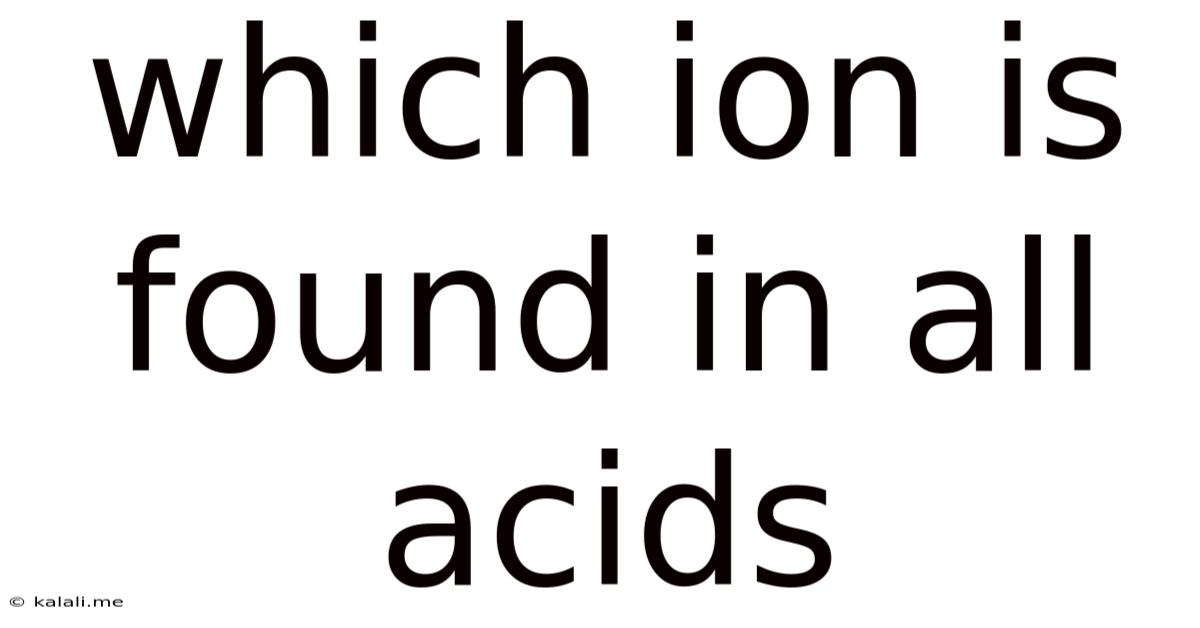Which Ion Is Found In All Acids
Kalali
Jun 11, 2025 · 3 min read

Table of Contents
Which Ion is Found in All Acids? Understanding the Nature of Acids
Acids are a fundamental part of chemistry, playing crucial roles in countless reactions and processes. But what defines an acid at its most basic level? The simple answer is the presence of a specific ion: the hydrogen ion (H⁺). This article will delve deeper into this defining characteristic, exploring its implications and clarifying some common misconceptions.
Understanding the presence of the hydrogen ion is key to grasping the concept of acidity. This ion, also sometimes referred to as a proton, is responsible for the characteristic properties of acids, such as their sour taste (don't try this at home!), their ability to react with bases, and their effect on indicators like litmus paper.
The Role of the Hydrogen Ion in Acid-Base Reactions
The hydrogen ion's role is central to the Brønsted-Lowry theory of acids and bases. This theory defines an acid as a substance that donates a proton (H⁺) and a base as a substance that accepts a proton. Therefore, all acids, by definition, contain or release hydrogen ions when dissolved in a solution. This donation of a proton is what drives many of the characteristic reactions associated with acids.
For example, when hydrochloric acid (HCl) dissolves in water, it dissociates into hydrogen ions (H⁺) and chloride ions (Cl⁻):
HCl → H⁺ + Cl⁻
This release of H⁺ ions is what makes the solution acidic. The concentration of these ions determines the strength of the acid. Strong acids, such as HCl and sulfuric acid (H₂SO₄), completely dissociate in water, releasing a high concentration of H⁺ ions. Weak acids, like acetic acid (CH₃COOH), only partially dissociate, releasing a lower concentration of H⁺ ions.
Beyond the Hydrogen Ion: Hydronium Ions (H₃O⁺)
It's important to note a slight nuance. While we often represent the hydrogen ion as H⁺, in aqueous solutions (solutions containing water), it actually exists primarily as a hydronium ion (H₃O⁺). This is because the highly reactive H⁺ ion readily bonds with a water molecule:
H⁺ + H₂O → H₃O⁺
So, while the hydrogen ion is the fundamental defining characteristic, in reality, it's often found as a hydronium ion in solution. Both representations are commonly used, and understanding the relationship between them is vital for a complete understanding of acid chemistry.
Differentiating Acids from Other Substances
The presence of the hydrogen ion (or its hydrated form, the hydronium ion) is what sets acids apart from other chemical compounds. Bases, on the other hand, accept these protons, leading to neutralization reactions. Understanding this fundamental difference is crucial for interpreting chemical reactions and predicting their outcomes.
In conclusion, the presence of the hydrogen ion (H⁺), often existing as the hydronium ion (H₃O⁺) in aqueous solutions, is the defining characteristic of all acids. This ion’s behavior and its interactions with other substances are key to understanding the fundamental properties and reactions of acids in chemistry. This understanding forms the bedrock of many concepts in chemistry, including pH, acid-base titrations, and buffer solutions.
Latest Posts
Latest Posts
-
How Long Is Mayo Good For After Expiration Date
Jul 01, 2025
-
How Many Oz In A Lb Of Pasta
Jul 01, 2025
-
What Year Was I Born In If Im 19
Jul 01, 2025
-
How Many Cups Is 238 Grams Of Miralax Powder
Jul 01, 2025
-
How Much Is Half A Billion Dollars
Jul 01, 2025
Related Post
Thank you for visiting our website which covers about Which Ion Is Found In All Acids . We hope the information provided has been useful to you. Feel free to contact us if you have any questions or need further assistance. See you next time and don't miss to bookmark.